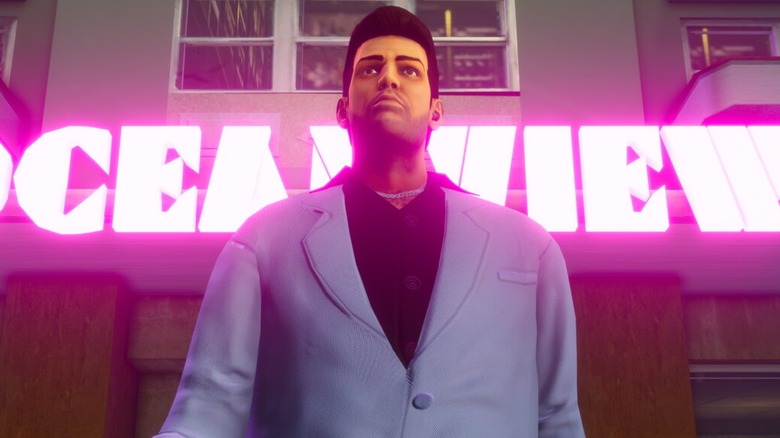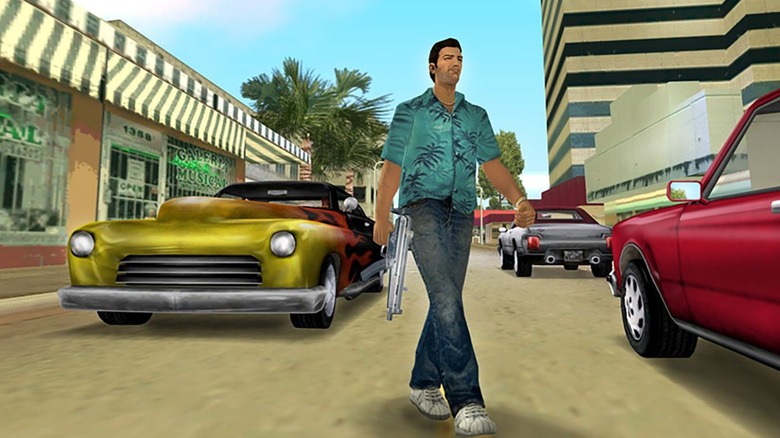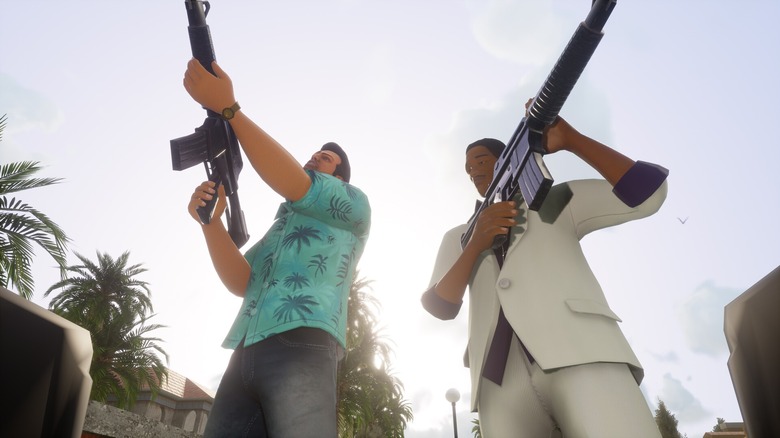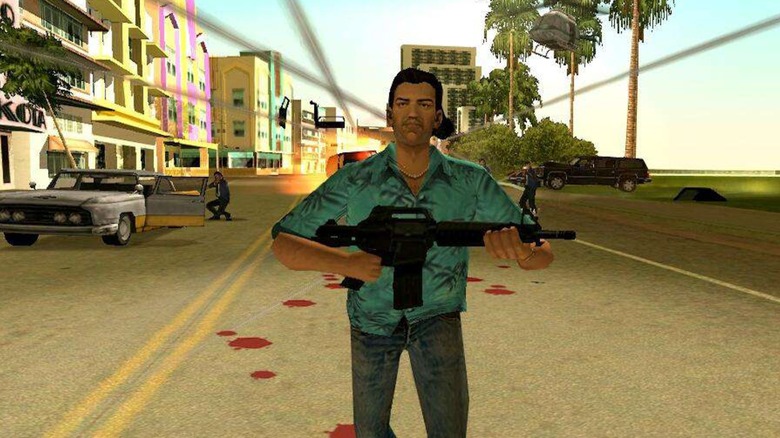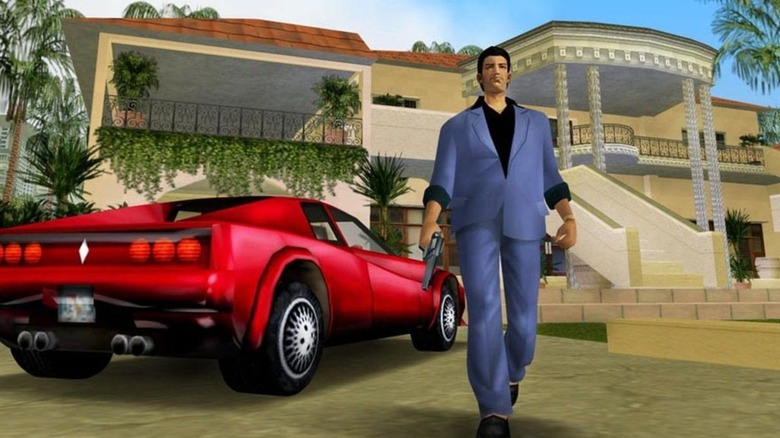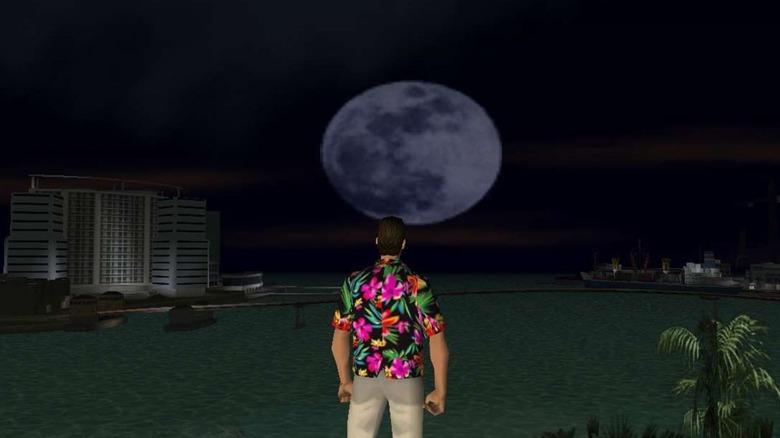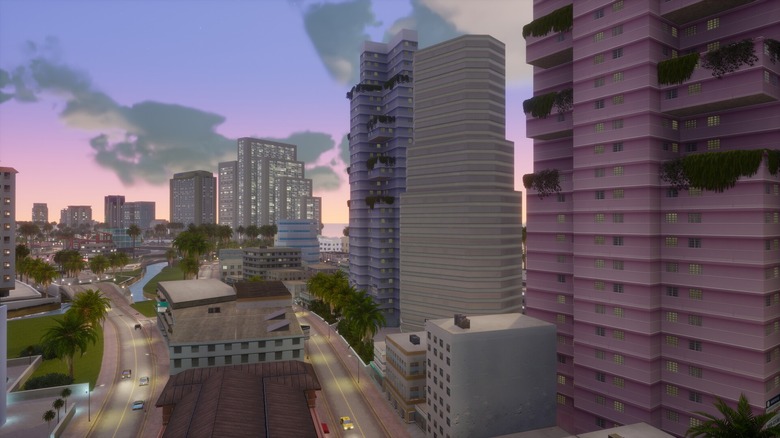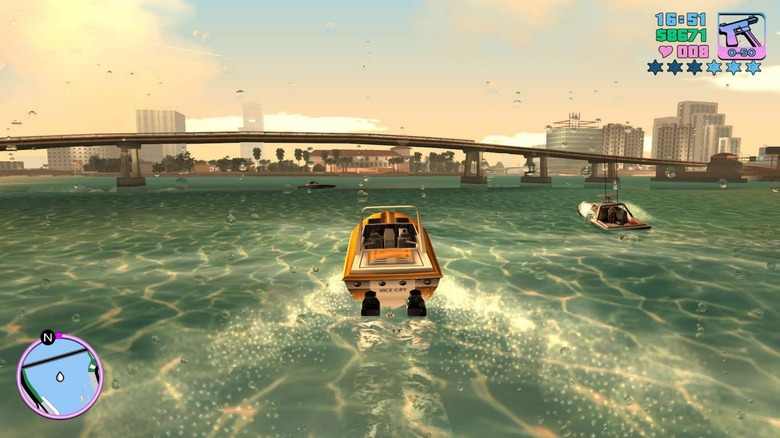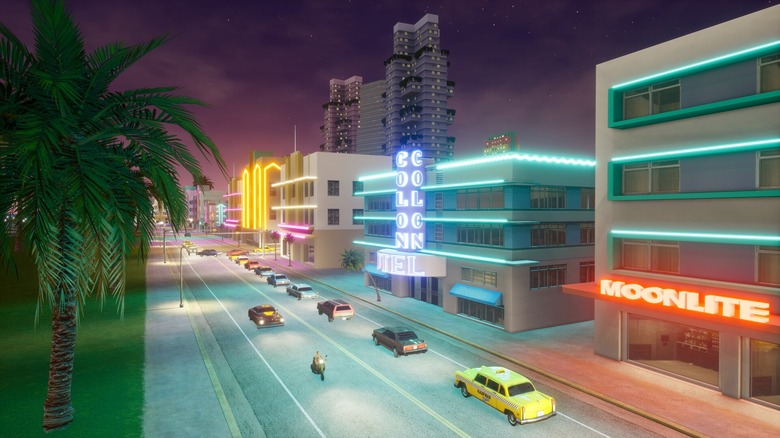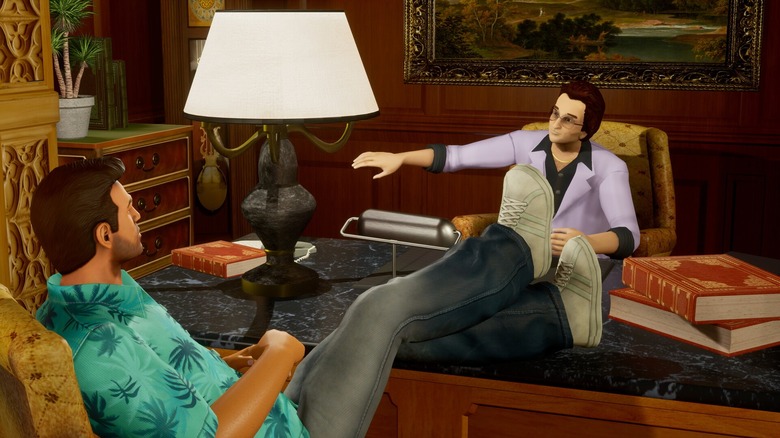We Replayed GTA: Vice City And It's Completely Different 23 Years Later
The release of "Grand Theft Auto VI" has gamers everywhere gearing up for a trip to Vice City, and we're no different. Rockstar's next game promises to be one of the biggest video game releases of all time, but "GTA VI" is extra exciting because it's going to let us revisit one of the coolest settings in gaming history.
"Grand Theft Auto: Vice City" was a mind-blowing game when it debuted back in 2002. Rockstar managed to create a highly stylized, completely believable open world city for gamers to get stuck into. It was ripe for exploration, role-playing, and satisfying those irresistible "GTA" urges to cause mass chaos. With its all-star cast and top-notch graphics, "Vice City" really seemed like the pinnacle of gaming at the time.
More than two decades later, "Vice City" is still a spectacular game. The "Vice City" story remains one of the best in the franchise, and the game has some of the most distinctive art direction in Rockstar's entire catalog. "Vice City" is as fun as it ever was, but even though the game is still enjoyable, the experience of playing it today is completely different than it was in the 2000s.
The first release version is a rarity
There is one version of "Grand Theft Auto: Vice City" that you're almost guaranteed not to be playing today: A year after Rockstar released "Vice City," the developer made the decision to censor its own game. Every "GTA" game has had problems with controversial material, and "Vice City" is no different. Like every game in the "GTA" series, it caused a massive outcry when it debuted. Many people claimed that "Vice City" glorified drugs, crime, and violence, and Rockstar's game faced censorship in places like Australia.
Perhaps the biggest controversy relates to a mission that offended the government and people of Haiti. There's a mission where Tommy is going up against a local Haitian gang. In the original version of the game, as Tommy heads into the fight, a title card pops up urging players to "Kill all the Haitians!" Haitians in the real world didn't appreciate this part of the game, and an activist group in New York City (where Take-Two Interactive, the parent company of Rockstar Games, is headquartered) urged then-mayor Michael Bloomberg to take "GTA" publisher Take-Two to court over "Vice City." Bloomberg threatened to do just that, but Take-Two and Rockstar responded to the concerns before the issue ever went to court.
"Take-Two Interactive Software, Inc. and Rockstar Games, Inc. wish to express our sincerest apologies to the Haitian people and Government of Haiti for any offense that may have been caused by statements made in the video game 'Grand Theft Auto: Vice City,'" a joint statement read, in part (via IGN). "In creating the game, it was not our intention to target or offend any group or persons or to incite hatred or violence against such groups or persons." Rockstar removed the offensive title card from all future versions of "Vice City," meaning that you won't see it in any edition of the game that you can buy new today.
Lance is a far better character now
Lance is at Tommy's cocaine deal at the beginning of "Grand Theft Auto: Vice City," and he later meets up with Tommy because he thinks the two of them can help each other out. He wants vengeance against local crime boss Diaz for killing his brother. Tommy and Lance aid one another in achieving their big goals, but then in a surprise twist at the very end of the game, Lance sells Tommy out to the mob. As entertaining as Lance's story was in "Vice City," his turn at the end felt like a plot device more than anything. The game just doesn't spend enough time exploring his character or justifying his decision. Today, though, Lance comes across completely differently.
That's because Rockstar also clearly saw that Lance had greater potential as a character, so the developers expanded on his backstory with a spin-off game called "Grand Theft Auto: Vice City Stories." Originally released on the PSP, "Vice City Stories" is a prequel that follows Lance's brother Victor Vance. We get to see Victor's tragic foray into the criminal underworld of Vice City, and we come to understand more about how his death impacted Lance. Thanks to "Vice City Stories," Lance's arc in the original game — and his surprising turn at the end — carry much more weight.
Hey, I know that guy!
Most "Grand Theft Auto" characters don't stick around for longer than a single game. That said, there are a couple of characters from "Vice City," aside from those who appeared in the prequel game, who went on to have longer careers in the world of "GTA." Thanks to the events of "Grand Theft Auto: San Andreas," we now know what happened to Ken Rosenberg after his partnership with Tommy ended: After a brief stint in rehab, the shady lawyer relocated to San Andreas.
Following his arrival in San Andreas, it doesn't take Ken long to fall back in with a similar crowd to his clientele in Vice City. Ken eventually crosses paths with a man named CJ and reminisces about his old friend Tommy while aiding CJ with some jobs that help him climb the ranks of the criminal underworld. It turns out Ken views the events of "Vice City" as the messy end of his glory days.
Kent Paul is another minor character from "Vice City" who made his way to San Andreas. While making the move, Kent gave up managing the band Love Fist to start promoting the Gurning Chimps on the west coast. Kent ends up working for the rapper Madd Dogg, and that's where his story makes contact with CJ's. Just like in "Vice City," Kent doesn't have much to contribute to the main quest in "San Andreas," but his presence helps sell the interconnectedness of Rockstar's ever-growing universe.
Whatever happened to Tommy Vercetti?
"Grand Theft Auto: Vice City" wasn't the first game in the series to feature celebrity voice actors, but it was the first to have a star voicing the lead character. In fact, "Vice City" marked the first time that a "GTA" game had a voiced protagonist, and Rockstar got Ray Liotta to play the role. At the time, Liotta was the first person to admit that he didn't really know what he was getting into. In an interview with Conan O'Brien, Liotta said, "I'm not a game player. I was never a 'Pac-Man' guy." As such, Liotta — who died of heart and respiratory issues while filming a movie in the Dominican Republic in 2022 — was completely shocked by how popular the game became and by how much fans loved his character in particular.
Liotta's prior inexperience with video games actually helps explain why Tommy Vercetti, despite his popularity among "GTA" fans, has never been seen or heard from since "Vice City." In a conversation with IGN, Liotta talked about the unique challenge of working on a game that allows players to go wherever they want and talk to so many different NPCs. "The scenarios that go on, it's exhausting," Liotta said. His exhaustion might have caused some tension behind the scenes, too: Rockstar co-founder Jamie King has said he had to manage Liotta's attitude during some grueling recording sessions. That might be part of why Tommy didn't make another appearance in a Rockstar game during Liotta's lifetime.
Now we know what could have been
The nine month development cycle for "Vice City" might sound like a dream for modern "Grand Theft Auto" fans who have to wait out entire console generations between Rockstar releases, but it comes with a cost. For one thing, making a game that quickly can be incredibly unpleasant for the developers themselves. "'Vice City' was kind of crazy, because we knew we had a one-year deadline and there were more expectations and there were so many things we wanted to do," former Rockstar technical director Obbe Vermeij told GamesRadar, adding, "That year was probably the most stressful year that I had at Rockstar."
In addition to potentially burning out developers, making a game that quickly also means sacrificing features. There's plenty to do in "Vice City," but the game isn't nearly as full as it could have been. In the years since "Vice City" landed on the PlayStation 2, we've gotten a peak at some of the content that had to be cut from the game because of Rockstar's tight deadline. The map was supposed to be significantly larger, and the devs had plans to make the Gator Keys an explorable area. There's also an array of weapons, cars, and even full missions that didn't get finished in time to make it into the final game. In 2002, gamers were thrilled that Rockstar had managed to churn out such a great game so quickly, but today we can't help but wonder what "Vice City" could have become with a little more development time.
Players know all of Vice City's secrets
Crime and chaos might be the main draw of "Vice City," but they aren't the only things that the game has to offer. As much as "Grand Theft Auto" is a franchise about telling serious crime stories, it's also a gaming series known for leaning into the goofier aspects of gaming. "Vice City" is packed to the brim with Easter eggs, movie references, and outrageous secrets to discover. Playing the game in 2002, there was something new to discover around every corner, whether it be a goofy movie reference or a baffling Easter egg.
Nowadays, we not only know where all the Easter eggs in "Vice City" can be found, but we also know how some of them came to be in the first place. The first time someone shot a sniper rifle at the moon and it changed size, their mind was blown. Now gamers know that the devs were arguing about the moon's size while simultaneously working on the sniper rifle and decided to make a joke of it. Knowing the locations and stories behind all the secrets in "Vice City" doesn't necessarily make the Easter eggs less fun to find, it just means that instead of feeling like a game of discovery, "Vice City" now feels a bit like a guided tour through an old museum.
Vice City kicked off a new GTA era
When you replay "Vice City" now, you'll inevitably notice how much this relatively small game influenced the future of the "Grand Theft Auto" franchise. From a writing perspective, by mimicking the style of popular crime movies, "Vice City" pushed "GTA" to become more cinematic. As previously mentioned, the game also introduced voiced protagonists into the series, and that's something "GTA" has never abandoned. While it raised the bar for the franchise's storytelling, the experience of making "Vice City" also pushed Rockstar away from Hollywood and got the company more interested in finding little-known actors to voice its characters.
From a gameplay perspective, "Vice City" is also a pivotal moment for the franchise. The game massively increased the variety of cars and weapons that players could use around the city, and it introduced sim mechanics like going to restaurants and changing outfits, things that have only become more prevalent as time has gone on. "Vice City" also tasks players with purchasing various businesses around the city to create a profitable criminal empire. That mechanic feels a little undercooked in Rockstar's 2002 game, but now managing businesses is a big part of the "GTA Online" experience. On a replay, "Vice City" feels like a laboratory where Rockstar experimented with some of the ideas that would eventually help it become the gaming industry juggernaut it is today.
It gives you video game development timescale nostalgia
People have been saying "They don't make games like they used to" since the second generation of video games, but replaying "Vice City" will make you a believer in the cliché. The game has a clear sense of style, a wide variety of mechanics to play with, and a world full of secrets to uncover. The story is populated with memorable characters, and the streets are filled with an array of different vehicles and weapons that can cause mass chaos. "Vice City" is a near-perfect little crime sandbox, and somehow the entire game was built in less than a year.
"Vice City" actually began its life as a planned DLC for "Grand Theft Auto III," but it quickly became so big that Rockstar realized it could cut it as a standalone game. In a nine month whirlwind, the game became the "GTA" classic that we know and love today. That kind of development timeline is simply unimaginable today, where gamers frequently wait a half decade or more between titles in a major series. With a 13-year gap between "GTA V" and "GTA VI" (and it will be even longer for "GTA" fans on PC), replaying "Vice City" will really make you wish that Rockstar could go back to its early 2000s approach.
Playing Vice City now comes with decision paralysis
In 2002, gamers just needed a PlayStation 2 to get their hands on "Grand Theft Auto: Vice City," but today there are quite a few more options available. The original game is still around, and now it's even easier to play. Even without a PS2, the original "Vice City" is playable on other consoles thanks to ports, and emulators are always an option for PC players. Despite the dated graphics, the strong art direction in "Vice City" keeps the game looking phenomenal decades after its release. The controls, however, haven't aged nearly as well, and combat in the original "Vice City" can be particularly grueling.
The 10th Anniversary Edition of "Vice City" that was released for iOS and Android changes up the control scheme and introduces some visual improvements, but for players who want a fully modernized control scheme, there's another option. Rockstar released the Definitive Edition of "Vice City" in 2021, and that version has smoother combat and updated features like weapon and radio selection wheels. Unfortunately, the Definitive Edition also made some dramatic changes to the look of "Vice City" in the name of updating the graphics. Playing "Vice City" now means making a choice between having the classic feel (and accompanying headaches) of the original game, or getting a smoother experience at the expense of the visual flair that made "Vice City" stand out when it first hit the scene.
Vice City will now live in the shadow of GTA VI
"Grand Theft Auto: Vice City" fans were given the gift of a lifetime when Rockstar decided to revisit the city with "GTA VI." Thanks to a series of "GTA VI" leaks, gamers strongly suspected that the next instalment would head back down south long before the developer gave official confirmation with the game's first trailer. The trailer drop was an undeniably great moment for Rockstar and its fans, but, oddly enough, it was something of a bittersweet event for fans of the original "Grand Theft Auto: Vice City."
Almost anyone who played "Vice City" will tell you that the game's setting deserved more from Rockstar. "GTA VI" is finally giving the city what it deserves, but that means that the original game will now forever feel like a preview for something bigger and better. There's no way that "GTA VI" will get rid of anyone's nostalgia for "Vice City," but with significantly more development time and an outrageously high budget, there's also no way that "GTA VI" won't feel like a fuller, more complete package than the classic game. As much as Rockstar's latest release is a celebration of the 2002 game that so many of us fell in love with, the existence of "GTA VI" will forever change the way we feel when playing "Vice City."

